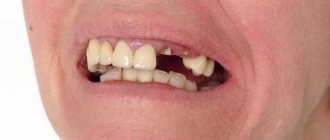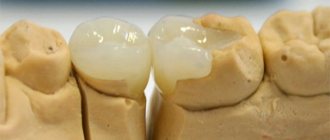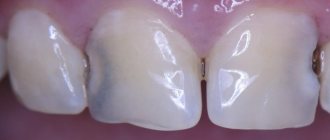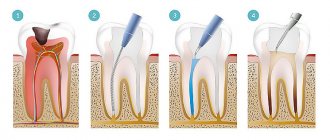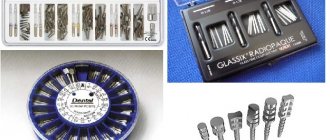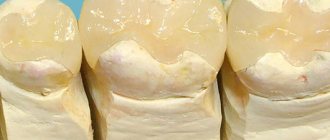1564
Restoring the integrity of a tooth after significant damage is a very popular procedure.
In addition to the quality of its implementation, an important factor for patients is the aesthetics of the final result.
One of the possibilities to restore a tooth, making it almost indistinguishable from neighboring elements of the row, is to fix a ceramic inlay.
General overview
The term inlay in dental practice refers to a type of microprosthesis used in the event of significant destruction of tooth tissue as a result of mechanical trauma or the development of a certain disease, for example, caries.
In terms of production technology, this design differs from a filling only in that it is made in a dental laboratory using a pre-made cast of an element of the patient’s jaw row.
Ceramic inlays have a long service life, and in appearance they completely copy the anatomical features of your own teeth that need restoration.
These permanent prosthetic structures restore the functionality and aesthetics of the units, preventing their further destruction and damage to adjacent teeth.
Kinds
Today, there are 3 types of ceramic inserts widely used in dentistry. Each of the elements has its own characteristics and is assigned under certain conditions.
Zirconium dioxide
Blanks made from the specified material are subject to subsequent turning. To obtain a model of the tooth and adjust the product to it, the prosthetist uses a plaster cast. It is installed in the oral cavity and completely follows the contours and cavities of the molar.
The turning process is automatic, it is carried out by a given program. The final product is fired and mixed with porcelain, after which it is installed on the patient.
This insert has an important advantage: the manufacturing process is not manual, therefore, errors are excluded. In addition, zirconium dioxide can be compared to metal in strength.
Pressed ceramics
During the production process of the liner, porcelain is treated with high pressure and temperature. The result is an excellent insert option that has enhanced aesthetic characteristics. Pressed ceramics have one drawback - this material is inferior to zirconium in terms of strength.
Metal ceramics
Products for dental prosthetics made from these raw materials are an innovation in dentistry. That is why experts have not yet improved the material. According to patient reviews, metal-ceramic inlays fall out very often. This occurs due to the difference in the indicators of the two components.
Composite
Another type of inlay, characterized by the same parameters as a regular filling. Over time, the composite product fades and darkens.
The most popular and used today is the all-ceramic insert. It is resistant to stress, aesthetically attractive and closely resembles enamel and dental tissue.
Indications and contraindications
Dentists identify the following specific indications for the use of products made from ceramic mass:
- a cavity in the element of the jaw row, which is limited by enamel;
- large cavities on the chewing surface of molars;
- carious cavities of class 2 according to Black, that is, damage to the contact surfaces of adjacent teeth;
- increased patient requirements for aesthetics;
- the need for gentle tooth preparation.
In addition to the listed situations, products can be installed if the patient has general indications for tooth restoration using microprostheses, for example, in the following situations:
- tooth destruction by one third, provided that the nerve is preserved;
- increased sensitivity of the dental covering;
- presence of enamel damage – chips, cracks;
- the need to restore the tooth for its further use as a support for a bridge or other type of prosthesis.
Despite the great potential for restoring the integrity of teeth using this method, dentists note that there are situations when the use of these microprostheses, including ceramic ones, is contraindicated.
Most often, specialists refuse to install patients for the following reasons:
- the area that should be subject to restoration is too small - in this case it is more advisable to use filling material;
- a large volume of tooth surface affected by caries , and the high intensity of this disease;
- tooth destruction by more than two thirds - it is better to install an artificial crown;
- bruxism , that is, uncontrolled grinding of teeth - in some cases, a specialist may recommend wearing special mouthguards at night;
- lack of regular and high-quality oral hygiene.
As a rule, dentists undertake installation only if the patient has permanent teeth . In their opinion, it is inappropriate to restore the dairy elements of the series in this way .
Creation and installation of veneers
- The first visit is to prepare the teeth: caries is treated, plaque is removed. Next, if necessary, part of the enamel is ground down. To cover the defect and protect the enamel, temporary overlays are fixed, which are made of plastic,
- After preparing the teeth, impressions must be taken - they will serve as the basis for the development of individual onlays,
- veneers are created from the selected material and are necessarily applied to a plaster model of the jaw. If computer modeling is used, the patient has the opportunity to see what a renewed smile will look like before starting treatment,
- Overlays are fixed for one visit - this will take about 2-3 hours. As with inlays, a special adhesive adhesive is used.
Veneers: before and after photos
Differences from a filling
Externally, the product does not differ too significantly from the filling, however, dentists note the following significant differences between these methods of restoring the integrity of the elements of the dental line:
- Manufacturing features. The filling is formed directly in the patient's mouth during the procedure for closing a carious cavity.
For the production of products, a preliminary impression of the tooth being processed is required. This is reflected in the accuracy of the final result.When placing a filling, repeated grinding or adding material may be required. When fixing products, this problem does not arise.
- Application area. Filling material is used to close minor cavities in all teeth.
The structures are used to restore larger defects of premolars and molars. As a rule, incisors and canines are not restored with their help, however, in some cases, dentists can use this method to restore the integrity of the tooth. - The degree of adhesion of the material. The gap between the product and tissues during operation can be no more than 2 microns.
This eliminates the possibility of loosening and falling out of the structure, as well as the re-development of caries. In the case of a filling, its loosening and loss occurs quite often, after 1-2 years of use. - Features of operation. Filling material, even high-quality, has a tendency to shrink, wear off, and change color during service. The product does not darken over time, does not shrink, and wears off evenly with the natural tissues of the tooth.
- Duration of use. Often, the service life of a filling, in particular a composite one, does not exceed 3-5 years. Experts provide a guarantee for ceramic products from 10 to 15 years.
What are Inlay Onlay Overlay tabs and indications for their installation.
Let's talk here about proper preparation of teeth for prosthetics.
At this address https://www.vash-dentist.ru/protezirovanie/nesemnyie-p/ottisknyih-materialov-ortopedicheskoy-stomatologii.html we will talk about the types of impression materials in dentistry.
What are tabs?
An inlay is a fairly simple and common way to restore the shape of a tooth. In essence, this is a filling, the installation style and some characteristics just differ. Inlays are created in the laboratory - not composite materials are used for their manufacture, but ceramics or zirconium. Such materials correspond to dental tissues, both in strength and color.
Tabs
On a note!
Inlays are analogues of large dental fillings. They are used primarily to restore the shape of lateral multi-rooted teeth.
Varieties
Depending on the material of manufacture, three types of products are used in dental practice: metal ceramics, pressed ceramic mass, and zirconium dioxide.
Metal-ceramic structures combine two materials - ceramic mass and hypoallergenic medical steel.
According to experts, these products have a significant drawback - different expansion coefficients of metal and ceramics when exposed to temperature.
This often leads to rapid loosening and loss of the product, so this type of microprosthesis is used quite rarely in dental practice.
To produce pressed ceramic , the porcelain injection molding technique is used, which uses high temperatures and pressure. This product is much stronger than the previous version, and in appearance completely imitates enamel.
Zirconium models have the greatest strength compared to the listed types of ceramic microprostheses.
To produce them, automated grinding of zirconium dioxide blanks is performed based on impressions of teeth in need of restoration.
After this, the resulting product is fired and covered with porcelain mass. The finished and fixed zirconium model is practically indistinguishable from your own tooth, so it can be used to restore the integrity of the frontal incisors and canines.
How is a dental inlay installed?
Basically, such prostheses are installed on living teeth, since if the tooth’s nerve is removed, or there is such a need, it means that the tooth is severely damaged and to restore it, it is no longer necessary to have an inlay, but a crown. The installation of a dental inlay occurs in four stages:
- Diagnostics
. First, it is necessary to examine the patient and carry out appropriate diagnostic procedures - take X-rays and computed tomography to obtain a more objective picture of the clinical case. However, it is possible to identify the need to install an inlay and adequately assess the degree of tooth destruction only after preparing the cavity.
- Preparation
. Many patients believe that a dental inlay will require more serious tooth preparation with the removal of a large amount of its tissue. This is not true. The tooth is ground down exactly as much as necessary depending on its destruction. You should not think that the doctor will specifically “bring” the cavity to the size at which the installation of a dental inlay is indicated. In our clinic, we always use the most gentle techniques and try to preserve living tooth tissue as much as possible.
- Manufacturing
. Typically, the time it takes for structures to be ready depends on the workload of the dental laboratory, but, as a rule, the manufacturing process takes about 7 days for any type of inlay.
- Fixation
. Before installing the inlay, the tooth cavity is sandblasted to create an adhesive surface. Next, the microprosthesis is fixed in the cavity with composite cement, and the exit points of the fixing material are ground. After this, occlusal contacts are checked using articulation paper to create multi-point contact of the prosthesis with antagonist teeth.
Installation technique
The procedure for restoring a problem unit consists of a number of successive steps:
- The dentist examines the patient’s oral cavity , conducts the necessary studies and draws up a plan for further treatment.
- If there is a previously installed filling, the specialist removes it , after which he carefully removes tissue affected by caries using special equipment. At this stage, it is necessary to remove all damaged tissue without including healthy tissue.
- A special agent is applied to the ground surface of the tooth to reveal missing areas of carious tissue.
- The final grinding of the surface of the tooth that needs restoration is carried out. The edges of the jawline element are smoothed using Arkansas stone. These actions are aimed at improving the adhesion of the molar and the product.
- After applying a protective agent to the molar, an impression is taken , which is transferred to the dental laboratory, where the construction is manufactured.
During the period it takes to create the model, the cavity drilled into the patient's tooth is closed with a temporary filling material.
After the microprosthesis is manufactured, the filling is removed and the product is secured using special dental glue. Then the structure is polished, which completely eliminates the difference between it and the surface of your own tooth.
Watch the video to see the process of installing a ceramic inlay.
Ceramic inlay - modern technology for dental restoration
Dental prosthetics using inlays has been practiced since the beginning of the twentieth century. The first inlays were mainly made of precious metals. This type of prosthetics is quite durable, but not aesthetically pleasing. With the development of dental technologies and materials, composite and ceramic inlays have become most widespread.
Of all the materials used in dentistry, ceramics (also called dental porcelain) are most similar in properties to natural tooth enamel. Ceramic inlays are durable, shiny and partially transmit light. A correctly installed ceramic inlay restores the strength of the tooth almost completely. In many cases, when the destruction of the coronal part of the patient’s tooth is quite extensive, but the tooth remains alive, installing a ceramic inlay avoids removing nerves and installing a crown.
Advantages and disadvantages
The use of ceramic inlays to restore tooth integrity has many advantages compared to other restoration methods.
Here are the main advantages:
- Possibility of use to eliminate significant cavities and destruction of the dental surface;
- high precision manufacturing of the microprosthetic structure , which eliminates the need for its adjustment, as well as the possibility of malocclusion after fixation;
- high degree of biocompatibility of the material with dental tissues and various prosthetic structures;
- strength and stability , that is, withstanding significant chewing load;
- lack of susceptibility to polymerization and shrinkage;
- ideal aesthetic properties - similarity to enamel, the ability to restore the anatomical structures of the tooth, non-susceptibility to staining;
- no feeling of discomfort during the operation of the microprosthesis;
- good wear resistance , long service life.
At the same time, the product is not without its shortcomings, the most significant of which are the following:
- Long duration of treatment. Manufacturing may take one to two weeks, requiring several visits to the dentist and the placement of a temporary filling.
- High price. The price of a microprosthesis significantly exceeds the amount that must be paid for installing a filling, which is why many patients refuse this method of restoring the dental surface.
The purpose of wax modeling of teeth and the doctor’s course of action.
In this publication you will find a detailed description of ultranir and reviews from experts about the quality of the products.
Follow the link https://www.vash-dentist.ru/protezirovanie/nesemnyie-p/koronki-np/kachestva-metallokeramicheskih-duceram.html to learn more about the pros and cons of Duceram crowns.
Types of tabs
Tabs are divided into types depending on the material from which they are made. In modern dentistry, inlays made of metal, composite and ceramics are used.
The metal tab is usually made of gold. Its advantages include high strength and good adhesion to tooth tissue. Among the minuses, one can highlight the not very good aesthetics - your interlocutors will immediately notice such a tab. Secondly, since it is attached to a special cement, which tends to dissolve over time, the metal insert may fall out. Thirdly, the tooth will need to be ground down more for a metal inlay than for other types of inlays.
As for the composite tab, it can be called a filling replacement. However, unlike a filling, a composite inlay is made by a technician outside the mouth, on a model, and then attached to the tooth using composite material. The advantage of this method is high aesthetics. The disadvantages include the loss of shine of such a tab over time.
Speaking about ceramic inlays, it is worth immediately noting that this is the most aesthetic type of tooth restoration. If it is done correctly, then even the dentist will never guess that it is not a real tooth.
In addition, inlays are divided into two types according to functionality: there are restorative inlays, which restore the coronal part of the tooth, and core inlays, which are inserted into the root of the tooth and serve as a reliable support for the crown. This material is dedicated to restorative ceramic inlays.
Possible complications
Fixation of the microprosthesis is accompanied by grinding down the surface of the tooth in order to remove tissue affected by caries.
With a highly professional dentist, this procedure does not cause problems, however, in some cases it can lead to the development of secondary caries - if the affected tissue or pulpitis is not carefully removed.
The increased sensitivity of the patient's teeth can lead to the fact that after installing a microprosthesis, at first there will be discomfort and a feeling of the presence of a foreign object in the oral cavity. Over time, this feeling will disappear.
In some cases, the patient may experience an opening of a cavity in the body of the tooth , which entails the loss of the inlay.
In this situation, you should immediately contact your dentist to re-fix the product or make a new microprosthesis.
Care
To ensure the durability of the ceramic inlay and ensure that the molar does not bother you anymore, it is recommended to adhere to the basic rules of dental care after the procedure:
- do not additionally and unnecessarily load the installed inserts;
- take care of your teeth as usual on a daily basis;
- Rinse your mouth with water after eating food.
The main feature that determines one of the advantages of these products is the lack of special care, which is necessary for other types of treatment. A standard ceramic inlay has a warranty period of 5 years. Proper care will extend the life of the element.
Service life and care
Dentists note that the minimum service life is 5 years, but often the product serves the patient much longer.
The warranty on microprostheses made of zirconium dioxide and pressed ceramics in many clinics is 10-15 years.
It should be understood that the duration of the service is influenced not only by the quality of its manufacture, but also by the actions of the patient himself.
Therefore, in order to extend the life of the microprosthesis, you should adhere to the following rules:
- brush your teeth at least twice a day for 2-3 minutes;
- rinse your mouth after every meal;
- avoid actions that lead to strong clenching of the jaws, as this can lead to mechanical damage;
- visit the dentist at least twice a year to sanitize the oral cavity and timely identify emerging problems.
Materials for the manufacture of inlays and onlays
At the moment, several materials can be distinguished among the highest quality:
- ceramics: such prostheses are characterized by fairly good strength and durability. They are distinguished by very high aesthetics,
- Pressed ceramic: This type of ceramic removes excess air, making it stronger. Naturally, the material is more expensive, but its service life is an order of magnitude higher than that of conventional ceramics,
- zirconium: the most advanced material, which is characterized by increased strength and incredible aesthetics. It is processed using computer modeling and a special machine, so the prosthesis is very accurate, almost perfect.
Thus, inlays and onlays are completely different dentures. Their use is justified in various clinical situations, and what to choose should be determined first of all by the attending physician (dentist therapist or orthopedist).
Video report of the work “before” and “after” implantation. Smile-at-Once clinic patients are provided with a lifetime guarantee!
Notice
: Undefined variable: post_id in
/home/c/ch75405/public_html/wp-content/themes/UltraSmile/single-item.php
on line
45 Notice
: Undefined variable: full in
/home/c/ch75405/public_html/wp-content /themes/UltraSmile/single-item.php
on line
46
Rate this article:
( 1 ratings, average: 5.00 out of 5)
dental restoration
Expert “Be very careful when choosing lumineers. It is simply impossible to install them in 1 day, as well as in a week. They require their production in a foreign clinic and subsequent transportation. This takes time - about a month. Otherwise, you are offered some other, cheaper option. Most likely, classic veneers that will be made in an ordinary Russian laboratory.”
Implant surgeon, orthopedist Roman Vladimirovich Magadov
Consulting specialist
Vasin Yuri Alexandrovich
Doctor rating: 9.3 out of 10 (3) Specialization: Orthopedic dentist Experience: 29 years
Reviews
Despite the high cost, ceramic inlays are very popular among patients in dental clinics, judging by the reviews.
This is due to their high quality, aesthetic characteristics and service life.
You can share your opinion about the use of ceramic microprostheses in the comments section.
If you find an error, please select a piece of text and press Ctrl+Enter.
Tags inlay ceramic inlay fixed dentures
Did you like the article? stay tuned
Previous article
Purpose of using turunda after tooth extraction
Next article
All the details of laser teeth removal
